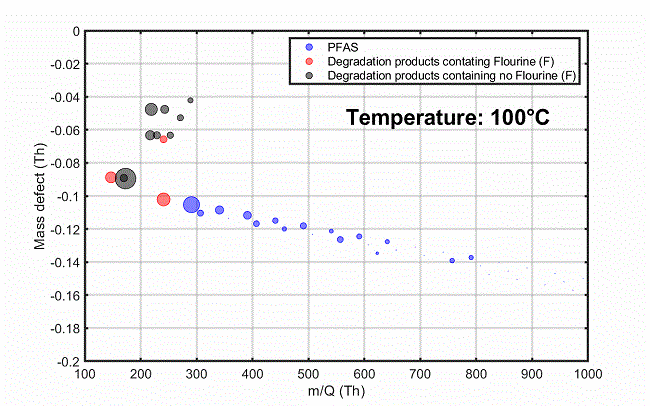Sponsored by TOFWERKReviewed by Aimee MolineuxAug 6 2024
Per- and poly-fluoroalkyl substances (PFAS) play an integral role in several facets of modern life and are found in applications across various industries.1 One prominent application is in the manufacture of semiconductors, where PFAS are utilized to construct components essential for semiconductor fabrication processes.
Due to the increasing concerns about the environmental and health impacts of PFAS and regulations regarding their emissions, regularly monitoring PFAS sources is integral in reducing the global PFAS burden.2
Experimental Methods
The experimental setup for the thermal release of PFAS from PFA tubing (which is commonly used for its distinctive chemical properties) is shown in Figure 1. Approximately 5 g of PFA tube was placed inside a stainless-steel oven which was continuously flushed with ultra-high purity nitrogen gas at 2 L per minute.
The temperature within the oven was gradually increased, at a rate of about 2 °C per minute, from 100 °C to 330 °C. The oven was connected to the inlet of a chemical ionization time-of-flight mass spectrometer (CI-TOFMS).

Figure 1. Experimental setup used in this study. Image Credit: TOFWERK
The subsequent emissions were detected using the fast polarity-switching capabilities of the TOFWERK Aim Reactor, attached to the Vocus B2, to capture emissions through the online measurement of positive and negative analyte ions.
Results
All relevant PFAS compounds were detected as the parent molecule clustered together with iodide reagent ions or as their deprotonated anion.3
Compounds were recognized based on their chemical formula through accurate mass-to-charge ratio measurement and isotopic patterns through fragmentation-free ionization.
Figure 2 (upper) shows a time series graph of representative PFAS compounds such as PFBA, PFHxA and PFOA (blue trace). The observed signal started increasing at 150 °C and stopped at around 250 °C.
At increased temperatures, the signal diminished, signifying that decomposition mechanisms play an important role.
As the discharged PFAS compounds degraded, the appearance of various known fluorinated degradation products including hydrofluoric acid and TFA (red trace) as well as non-fluorinated compounds (e.g. fulminic acid) could be observed (black) (Figure 2).
Comparable results have been previously reported.4

Figure 2. Time series of some compounds emitted from the material as a function of oven temperature (top) and mass defect plots showing total emissions at three temperature points: (A) 100 °C, (B) 250 °C and (C) 330 °C. Image Credit: TOFWERK
The mass defect plot in Figure 2 (lower) displays the total material emissions at three different temperature points. At the start of the heating process (around 100 °C), minimal PFAS emissions were observed from the sample.
Around the 250 °C mark, elevated PFAS emissions, including long-chain perfluoroalkyl carboxylic acids (PFCAs) with a carbon chain length of 9 to 18, could be observed.
After the temperature exceeded 250 °C, various fluorinated and non-fluorinated compounds could be seen at elevated levels. These non-fluorinated compounds are illustrative of various plasticizer products. Volatile hydrocarbon emissions, as measured by benzene cations, remained low at the temperatures investigated here.

Figure 3. The evolution of material emissions is depicted as a function of temperature. Image Credit: TOFWERK
Conclusion
The Vocus B Series, with iodide reagent ions, supports the real-time monitoring of PFAS emissions from PFA tubes in the gas phase.
Although the hydrocarbon emissions of PFA are very low, it is likely that the comprehensive nature of the Vocus B series is significant for other material off-gassing applications.
Inclusive emissions and thermal degradation information is fundamental for optimizing processes and ensuring compliance with regulations, in particular for high-performance materials subjected to a range of processes and environmental conditions.
Acknowledgments
Repurposed from materials originally authored by Priyanka Bansal, Felipe Lopez-Hilfiker and Katie Schmidt from TOFWERK.
References and Further Reading
- Gaines L. G. T. (2022). Historical and current usage of per- and polyfluoroalkyl substances (PFAS): A literature review. American Journal of Industrial Medicine, 66, pp.353-378. https://doi.org/10.1002/ajim.23362
- Panieri E., et al. (2022). PFAS Molecules: A major concern for the human health and the environment. Toxics, 10, 44. https://doi.org/10.3390/toxics10020044
- Bowers, B. B., et al. (2023). Evaluation of iodide chemical ionization mass spectrometry for gas and aerosol-phase per- and polyfluoroalkyl substances (PFAS) analysis. Environmental Science: Processes & Impacts, 25, pp.277-287.https://doi.org/10.1039/D2EM00275B
- Mattila, J. M., et al. (2024). Characterizing volatile emissions and combustion byproducts from aqueous film-forming foams using online chemical ionization mass spectrometry. Environmental Science & Technology, 58, pp.3942-3952. https://doi.org/10.1021/acs.est.3c09255

This information has been sourced, reviewed and adapted from materials provided by TOFWERK.
For more information on this source, please visit TOFWERK.